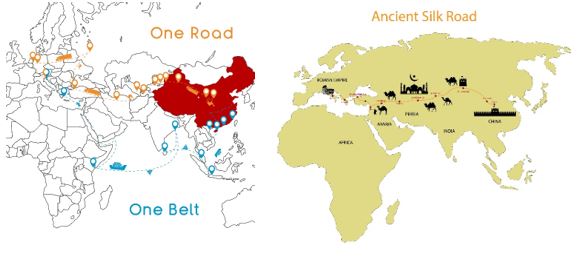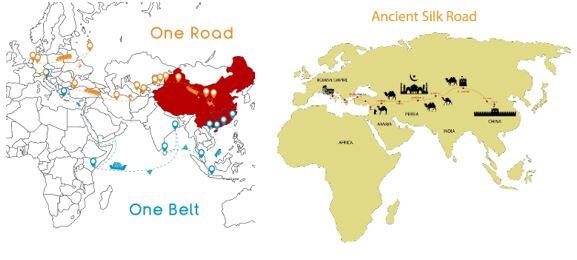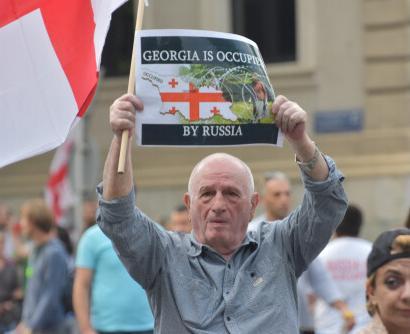Abstract: After 40 years of unprecedented economic growth, China is finally in a position to challenge the existing global order. Belt and Road Initiative (BRI), a monumental global investment plan which impacts Europe, stirring controversy in some and affinity in others. The EU has acknowledged the risks of Chinese influence through BRI. Nevertheless, a joint EU position rests in obscurity. Central and Eastern European countries that were early to join a special type of cooperation, 17+1, are changing their position towards China. Meanwhile, Hungary, Serbia, and Greece appear to remain devoted to Chinese cooperation and investment opportunities. G7 members, the United States (US), and the EU have sought to counter the Chinese BRI with their own versions, Build Back Better for the World (B3W) and the Global Gateway. Only time will tell how their investment endeavours will compete with the Chinese BRI. The lack of unity amongst the Western world creates the possibility for individual EU countries to succumb to the Chinese sphere of influence.
Bottom-line-up-front: The Chinese Communist Party’s leadership of Xi Jinping of the People’s Republic of China has profoundly transformed the Chinese position as a global power. The New Silk Road or the Belt and Road Initiative (BRI) is its prime archetype. BRI is inspired by a historical trade route, connecting China to the West from 114 BCE to 1450 CE, and it is once again being reinvigorated. In Europe, the BRI is ramified in various forms. The EU, NATO, and G7 members are ever-increasingly sceptical over China’s BRI intentions and are working on contingency strategies.
Problem statement: How to counteract Chinese global proliferation via the Belt and Road Initiative that has shown to not only exert economical cooperation with European countries but also its geostrategic proliferation and exploit eastern oriented countries in the EU and Europe?
So what?: The United States, the pillar of the West, and democracy is increasingly finding itself challenged by a strong contender of an autocratic government, China. Western powers, such as the United States, the European Union, NATO, and G7 members should unite in their common democratic values to find a common strategic framework to counteract autocratic governments. The Belt and Road Initiative is a valuable asset to developing nations in need of FDIs, however, its past endeavours proved to be pernicious.

Source: shutterstock.com/nadiia_oborska and /Nasky
What is the Belt and Road Initiative?
Xi Jinping, the Chinese president, first made a monumental economic development and global connectivity plan public in 2013 at a Kazakhstan University under the name ‘One Belt, One Road’ or what is known today as The Belt and Road Initiative. The idea stems from the historical land and maritime trade route known as the Silk Road that began in Xi’an in the 2nd Century BCE during the Han dynasty, connecting the East with the West. Inspired by the ancient Silk Road, the BRI is a colossal infrastructural network connecting geographical regions to the thriving Chinese economy.
The BRI, under the auspices of the People’s Republic of China (PRC), seeks to connect the Chinese economy with the world through infrastructure investments, particularly in countries that have struggled to attract FDI in the past. The BRI is projected to cost an estimated one trillion dollars and have a presence in over 130 countries[1]. Land routes such as highways, bridges, airports, tunnels and railways, make up “the silk road economic belt”, that pass through central Asia and the Caucuses[2]. The road or the “21st century Maritime silk road” refers to the maritime route in terms of ports and dams, passing through Indo-Pacific sea routes. Moreover, the BRI encompasses digital infrastructure such as the 5G network and power and water infrastructure.
The BRI, under the auspices of the People’s Republic of China (PRC), seeks to connect the Chinese economy with the world through infrastructure investments, particularly in countries that have struggled to attract FDI in the past.
The paramountcy of this endeavor is demonstrated by its incorporation into the Chinese constitution in 2017 with a set completion date in 2049, which also marks the 100th anniversary of the PRC. Prior to the BRI, in 1999, the government developed a “Go Out” policy, which was used to nudge Chinese firms to bid for contracts and invest abroad in order to reap raw materials, enter global market competitiveness, and integrate into the global economy. China is barren in terms of raw materials, hence the need to seek raw materials to support its manufacturing powerhouse. Specifically, rare earth minerals for producing electric cars, manned and unmanned aircrafts, batteries, and lightweight materials for jet engines and rocket noses[3].
The BRI in Europe
In 2013, Xi Jinping introduced the BRI at the Nazarbayev University in Kazakhstan, manifesting Chinese intentions in Central Asia, Africa, and the Middle East. It wasn’t until 2015 that the BRI was introduced in Europe. A year after Xi Jinping’s inaugural BRI speech in Nur-Sultan, follows Xi Jinping’s more apprehensive but sanguine speech in Paris during the official visits of Sino-French diplomatic relations.; a speech inspired by Xi’s ideologue, Wang Huning’s China’s Dream, an idea based on the great renewal of the Chinese nation and the end of the Chinese century of humiliation. Between 1839-1949, China was under the Qing dynasty and as a Republic was under Western powers’ occupation. Consequently, the Chinese nation was crestfallen and forlorn by a century of subjugation. Nevertheless, the BRI is not mentioned, but this speech symbolizes the first step to cultivate relations with Europe.
Besides Xi’s visit to France, official visits were conducted throughout Germany, Italy, and Belgium. Simultaneously, Chinese financial institutions began flooding Europe with investments. At this time, Europe was still recovering from the financial crisis of 2008-2009, which would converge the interests of the BRI and the Juncker Plan regarding European financial recovery. Italy, significantly affected by the financial crisis and the rotating president of the council of the EU, became China’s entry point. The People’s Bank of China began acquiring two percent of important Italian firms, namely, ENI, ENEL, Fiat Chrysler, Telecom Italia, Generali, and Mediobanca[4]. As the investments started to pour in, the Pew Research Center reported a hike in the European public opinion of China, with favorable views growing 14% in Italy, 6% in Germany, and 3% in France. 2015 rolled around, and the BRI intentions for Europe were finally announced with the National Development and Reform Commission in combination with the ministry of commerce publishing BRI’s “action plan”. The UK, Germany, France, and Italy were the first to join the Infrastructure Investment Bank (AIIB), a Chinese multilateral bank closely associated with BRI projects[5]. This event marked European’s acceptance of the Chinese contribution to global development and its role in the world order.
From a European perspective, the BRI offers numerous advantageous infrastructural developments. Specifically, railway and port infrastructure would ultimately interconnect the two and expand trade by steadily lowering transportation costs and increasing trade volumes.
The most vital for the BRI in Europe is the New Eurasia Land Bridge Economic Corridor and the Maritime Silk Road. A railway network connecting factories across Europe span all the way to London also referred to as an express lane to Europe. The Maritime Silk Route enters Europe through the Southeast to the port of Piraeus in Greece and Trieste in Italy. Moreover, China’s Arctic Policy sets out an ambition to develop a Polar Silk Road, which would connect to Europe via the North Sea.
From a European perspective, the BRI offers numerous advantageous infrastructural developments. Specifically, railway and port infrastructure would ultimately interconnect the two and expand trade by steadily lowering transportation costs and increasing trade volumes.
The railway development will be more evident in Central and Eastern Europe like Germany, Poland, and Czechia. Railway transportation is more costly than Maritime which is an even more crucial aspect of the BRI. In terms of volume and value of trade, the Mediterranean and Southern Europe make the key shipping route of the BRI. One such example is the Piraeus Port in Greece, which is also the main port of Athens, which has been acquired by 67% by China’s largest state-owned shipping company, Cosco[6]. This is also the first time that a Chinese Company owned a majority of an EU member’s port. Furthermore, the Chinese have invested over five billion dollars in expanding the port along with signing a contract with Hungary to build a high-speed train that could potentially link the Greek port with the railway into a transhipment station, allowing China the main gateway to Central and Eastern Europe[7]. This particular ambition has raised alarms for the European Commission as Hungary did not go through the public tender process for the high-speed train, as prescribed by the EU public procurement regulations.
The four types of cooperation that the BRI in Europe consists of are:
- Eastern states, Germany, the Netherlands, Belgium, and Finland cooperate on specific projects such as the Peljesac Bridge in Croatia, the railway line between Budapest and Belgrade, or the Skopje-Shtip highway in Macedonia.
- The second type of cooperation is built on financial aspects. Meaning that European countries invest in projects in their own countries but are globally connected with the BRI. These include Austria, Czechia, Luxembourg, United Kingdom, and Switzerland.
- This cooperation is related to health, education, and other support mechanisms and usually Scandinavian countries and Ireland participate in such.
- Lastly, this type of cooperation is a combination of all forms and only Poland and Iceland are involved.[8]
Moreover, China has formed a 17+1 initiative in 2012 in Budapest, Hungary, which is basically an extension of the BRI but specifically tailored for investments in 17 EU and non-EU countries. Under the agreement called a Memorandum of Understanding (MoU), a letter of intent is signed between a government entity agreeing to cooperate with China in one way or another. It includes 12 EU member states located in Central and Eastern Europe and five non-EU countries such as Albania, Serbia, Montenegro, Bosnia, and Macedonia[9]. The 17+1 initiative meets annually in one of the member states; however, given the covid-19 pandemic, the conference has been held virtually. This initiative is in a deteriorating phase, where certain members have shown discontent and Lithuania leaving the initiative all together[10].
Geopolitical Risks for Europe
China has continuously professed the “win-win” situation of the BRI for itself and the countries in which it invests. Nevertheless, economical cooperation garners political influence as well. The EU has been ever increasingly sceptical over Chinese motives. Specifically with rising debt amongst South and Eastern European countries as a result of the BRI projects. Brussels outlines the main concerns as: a rise of indebtedness of the EU countries by ways of receiving credit and support from China, political risks that countervail European democratic values, low ecological and security standards, and dangers of EU disintegration in terms of supporters and foes of BRI[11].
The EU has been ever increasingly sceptical over Chinese motives. Specifically with rising debt amongst South and Eastern European countries as a result of the BRI projects.
Beijing’s assurances that the BRI investments aimed to improve infrastructure, create employment, technology transfer, and other development projects would ultimately benefit the host countries have been questionable. However, a study done by economic experts on China have revealed patterns of China’s bank lending practices that have proven to be neither economically feasible nor attractive. Hence, why many times projects in developing countries have previously not been followed through [12]. The loans come from Chinese banks to developing countries where they are negotiated bilaterally and many times in secret. The loans are usually backed by collateral such as rights to a mine, a port, or lease of territory for Chinese purposes until a debt is repaid.
Montenegro: A Debt Trap in Europe
Montenegro was the only country in Europe that did not have a highway, and the government has previously asked multiple times of the EU and Western countries to help them invest in a highway stemming from the coastal city of Bar to Belgrade in Serbia. The EU has refused to finance this project as it did not garner significant traffic and the European Central Bank concluded that it wouldn’t be financially sustainable. The investment would have a hard time being paid off or break even. Given the small population of 620,000 and a vast mountainous geographical composition, building a highway with meagre traffic would have been far too costly. Nevertheless, in 2014, under the BRI, China agreed to build the highway for $3.2 billion spanning 160 km[13].
The project to this day is incomplete, reaping over 100% of Montenegro’s gross domestic product (GDP), and it holds ¼ of Montenegro’s total debt[14]. The IMF this year in May has stated that Montenegro cannot take any more debt to finish the project. Currently, only 40 km have been completed out of 160. 70% of the workforce is Chinese and not local, which contradicts claims of fostering employment in host countries. Moreover, NPR has revealed a copy of the contract between Montenegro and the Chinese lending bank Export-Import (EXIMO), which states that the bank will have the right to seize land inside Montenegro unless the loan is paid on time, however, not for military or diplomatic purposes[15]. Regardless, this is quite a colossal issue. At present, Montenegro is in desperate need of financial help from the EU and the IMF. The EU was persistent that Montenegro should have listened to the EU’s advice and will not help pay a loan extracted from a third country. Albeit, as of recent this year in June, Brussels is looking to help with a combination of Germany’s Reconstruction Credit Bank, the French Development Agency, and Italy’s CDP Investment Bank in refinancing[16].
China’s interest in the small country of Montenegro is multifaceted. Montenegro is a candidate for EU membership and expected to enter in 2025. However, the EU might be forestalling. Montenegro is also part of NATO, and there is concern that it will fall to Chinese influence as there might be a possibility of giving China control over its public assets since it cannot repay the debt. The country is located on the Adriatic coast, one of the BRI’s main maritime transport routes. It’s also important to note that other Balkan countries have been getting close to China, the main country being Serbia, which has garnered Chinese political and economic influence over the years. China could also use Montenegro as a center for greater opportunities and involvement in Europe. Hence, raising alarms in the EU.
Montenegro is also part of NATO, and there is concern that it will fall to Chinese influence as there might be a possibility of giving China control over its public assets since it cannot repay the debt.
Europe’s Response
The EU is coming to a realization that perhaps BRI investments in the EU, specifically Southern and Eastern European countries, aren’t exactly a “win-win” situation, as China likes to profess. The 17+1 initiative is quite fragile, especially after Lithuania’s departure. The rest of the member countries are growing dissatisfied with the BRI’s results. Many of the projects have been delayed, canceled, or put on hold. Furthermore, virtual conferences have been ineffective and brought on protest by most members not attending; only Serbia, Hungary and Greece attended. In 2020, Latvian’s intelligence services had labeled China as a threat to Western values and pointed out their serious human rights violations against the Uighur Muslim minority in China[17]. Lithuania opened up a Taiwanese representative office of its first kind in the EU under the name Taiwan and not Taipei, which has furtherly strained relations between the two[18]. It can be assumed that other Baltic states will follow Lithuania’s departure from the 17+1 initiative as they usually coordinate their politics away from Russia and towards the US and UK, given their occupational history. As more and more countries in Europe counteract China’s BRI, Serbia, Hungary, and Greece are holding on.
The EU is coming to a realization that perhaps BRI investments in the EU, specifically Southern and Eastern European countries, aren’t exactly a “win-win” situation, as China likes to profess.
Italy, which was once the BRI’s biggest partner, has taken a turn with the election two years ago of the Prime Minister, Mario Draghi that ended the close relationship with China. Under US pressure, the last Italian government had been decreasing its involvement with BRI projects. However, Draghi has signaled Italy’s foreign policy shift and back to its pro-European and Atlanticist position. However, the Hungarian Prime Minister, Victor Orban is one of the European leaders that is diplomatically amicable with China, not just through BRI cooperation but also in his strategy of “Eastern Opening” that has increased relations with China. Orban has agreed to build the Fudan University, the first Chinese university built on European soil if it passes through. This agreement has sparked much controversy amongst Hungarians, with ⅔ opposing the planned opening in 2024. The university is expected to cost 1.5 billion euros with which China plans to grant in the form of a loan to Hungary[19]. Direkt36, an online investigative news platform, published that “Orban’s Eastern Opening policy helped Chinese Intelligence set foot in Hungary, turning the country into a collision zone between China and the US”[20]. Ordinary Hungarians are showing major concern over Orban’s increasingly authoritarian rule and see this university plan as going too far in kindling with Chinese political ideology. Clive Hamilton, a China specialist, has furtherly stated that “the Fudan campus would be first and foremost, to groom and co-opt Hungary’s political, business, and intellectual elites”[21]. Nevertheless, Hungarian opposition parties have stated that whoever takes power after Orban will scrap plans for the university and have sent a letter to Beijing announcing its intentions to do so under future leadership.
In June this year, leaders of the 30 NATO countries met in Brussels to address various world issues, one of the main topics on the agenda was Chinese proliferation as a global power and its questionable assertive behavior that counter the current international order. A joint strategy for China is in the making and should be complete by 2022. NATO is in the process of transpiring such measures to address growing Chinese opposing policies, specifically economic coercion in the form of BRI towards other countries[22]. A similar development has been the meeting of G7 nations and their alternative action plan to counter the BRI called Build Back Better for the World (B3W)[23]. This project aims to assert western values of doing business, with an emphasis on human rights and labor laws, on the countries in need of infrastructure investment. This alternative would be combined with the US, G7 partners, the private sector and other stakeholders to work towards infrastructure investment abroad. The B3W would focus on the environment, anti-corruption, free flow of information, and responsible financing of projects that would allow countries to avoid excessive debt, which are all aspects that the BRI garners criticism in.
A joint strategy for China is in the making and should be complete by 2022.
Similarly, the European Commission President Ursula von der Leyen has announced a countering initiative against the BRI called “Global Gateway”. This EU scheme would serve almost identically to the BRI in terms of global infrastructure investments, but with responsible financing, von der Leyen fervently expressed that “We want to create links and not dependencies”[24]. However, how effectively this will work outside the EU is questionable as unstable autocratic countries will find it easier to make bilateral investment agreements with China. Which poses the question as to whether the EU will overlook human rights abuses, environmental disregard, and unfair labor laws to form the Global Gateway initiative in other countries? It is unclear at this time in which direction and how effective the EU’s Global Gateway will be next to the Chinese BRI.
Another unsettling issue is the close relationship between the former Chancellor of Germany, Angela Merkel and China. China is Germany’s main trading partner and the biggest market for German automobile companies. The US’s distancing and increasingly hawkish stance toward China has not prompted Germany, a close ally of the US, to follow suit. Instead, Merkel has sought to mitigate good relations between the two and continue enjoying business opportunities with China. Nevertheless, Germany’s stance may vary over the next year as a new Chancellor is due to be appointed this year. Environmental and labor law issues are the biggest concern when it comes to cooperation with China. Specifically, Beijing’s financing and building polluting coal-fired power plants and other environmental disregards. Technically, China is still considered a developing nation. Therefore, it doesn’t have to follow such stringent rules for the environment like developed countries. However, this is projected to change in 2023 when China is no longer developing but rather a high-income country, which also means that it will have “common but differentiated responsibility” when it comes to efforts to mitigate climate change[25].
Next Steps
The BRI is part of the global strategy of Chinese place in the new world order, especially Xi Jinping. His personal involvement in this strategy was crucial for a successful start and development of this initiative. The global strategy of spreading Chinese influence in the world has many variations. The BRI is the most crucial, it is only natural that it generates much controversy in the Western world. The EU has recognized the threat of Chinese influence at home and abroad. The recent statements and counteractions against the BRI were announced during this years’ State of the Union Address by the European Commission President. Similarly, G7 members have come out with their own BRI countermeasure, the B3W. NATO planning how to proceed with Chinese global proliferation.
The global strategy of spreading Chinese influence in the world has many variations. The BRI is the most crucial, it is only natural that it generates much controversy in the Western world.
Western countries have certainly recognized challenges posed by China and now are scrambling for solutions. A weak link in this scenario is the lack of unity and willingness to cooperate with each other. Despite von der Leyen’s calls for a closer relationship between the EU and the US, and further, expressing that the “EU will always be on the side of democracy and that is the US”, nothing of concrete nature has been done so far[26]. Germany’s complacency is witnessed by its tight economic relations with China all the way to the recent security pact between the US, UK, and Australia in the Indo Pacific, excluding France and the EU. Hence, an opportunity for China to exploit this weakness. A strategy that Russia has pursued, is to bilaterally deal with individual nations, causing disunity and hastening conflict to its advantage. China can impeccably use this to its advantage as well when it comes to the BRI in Europe. Bilaterally BRI cooperation with individual EU and non-EU states, causing disintegration and dispute in Europe as a whole.
Lana Pedisic is a current M.A. student of Global Security and Strategy at the Brussels School of Governance. She has a BSc in International Business from Rochester Institute of Technology. Her focus is on the Chinese Belt and Road Initiative and its impact in Europe, where she has done research on and lectured at the Foreign Policy Institute in Ankara, Turkey. The views contained in this article are the author’s alone and do not represent the views of the Brussels School of Governance.
[1] “New Routes and Strategic Partnerships for BRI beyond 2020,” The Economist, April 2019 https://www.bakermckenzie.com/-/media/files/insight/publications/2019/09/ecn_exec_summary.pdf?la=en.
[2] Andrew Chatzky and James McBride, “China’s Massive Belt and Road Initiative,” Council on Foreign Relations, January 28, 2020, https://www.cfr.org/backgrounder/chinas-massive-belt-and-road-initiative.
[3] Bashar Malkawi, “China’s Raw Materials Strategy,” Policy Forum, January 23, 2020, https://www.policyforum.net/chinas-raw-materials-strategy/.
[4] Rachel Sanderson, “China Swoops in on Italy’s Power Grids and Luxury Brands,” Financial Times, October 7, 2014, https://www.ft.com/content/1bd60160-4496-11e4-bce8-00144feabdc0.
[5] “How Countries View China,” Pew Research Center’s Global Attitudes Project, July 24, 2020, https://www.pewresearch.org/global/2014/07/14/chapter-2-chinas-image/.
[5] “Asian Infrastructure Investment Bank: France, Germany and Italy Said to Join,” Guardian News and Media, March 17, 2015, https://www.theguardian.com/world/2015/mar/17/asian-infrastructure-investment-bank-france-germany-and-italy-said-to-join.
[6] David Glass, “Cosco Shipping RAISES Stake in Piraeus Port to 67%,” Seatrade Maritime, August 24, 2021, https://www.seatrade-maritime.com/ports-logistics/cosco-shipping-raises-stake-piraeus-port-67.
[7] Andreaa Brînză, “China and The Budapest-Belgrade Railway Saga,” The Diplomat, October 30, 2020, https://thediplomat.com/2020/04/china-and-the-budapest-belgrade-railway-saga/.
[8] Franziska Sielker and Elisabeth Kaufmann, “The Influence of the Belt and Road Initiative in Europe,” Taylor & Francis, September 2, 2020, https://www.tandfonline.com/doi/full/10.1080/21681376.2020.1790411.
[9] Franziska Sielker and Elisabeth Kaufmann, “The Influence of the Belt and ROAD Initiative in Europe,” Taylor & Francis, September 2, 2020, https://www.tandfonline.com/doi/full/10.1080/21681376.2020.1790411.
[10] Stuart Lau, “Lithuania Pulls out of China’s ’17+1′ Bloc in Eastern Europe,” POLITICO, May 21, 2021, https://www.politico.eu/article/lithuania-pulls-out-china-17-1-bloc-eastern-central-europe-foreign-minister-gabrielius-landsbergis/.
[11] Erik Brattberg and Etienne Soula, “Europe’s Emerging Approach to China’s Belt and ROAD INITIATIVE,” Carnegie Endowment for International Peace, October 19, 2018, https://carnegieendowment.org/2018/10/19/europe-s-emerging-approach-to-china-s-belt-and-road-initiative-pub-77536.
[12] “What 100 Contracts Reveal about China’s Development Lending,” The Economist Newspaper, March 31, 2021, https://www.economist.com/finance-and-economics/2021/03/31/what-100-contracts-reveal-about-chinas-development-lending.
[13] Noah Barkin and Aleksandar Vasovic, “Chinese ‘Highway to Nowhere’ Haunts Montenegro,” Reuters, Thomson Reuters, July 16, 2018, https://www.reuters.com/article/us-china-silkroad-europe-montenegro-insi/chinese-highway-to-nowhere-haunts-montenegro-idUSKBN1K60QX.
[14] Srdjan Jankovic, Reid Standish and Gjeraqina Tuhina, “Montenegro Getting European Help to Refinance Its MASSIVE China Debt,” Radio Free Europe Radio Liberty, June 23, 2021, https://www.rferl.org/a/montenegro-china-debt-eu-assistance-refinance-1-billion-motorway/31322151.html.
[15] Rob Schmitz, “How a Chinese-Built Highway Drove Montenegro Deep Into Debt,” NPR, June 29, 2021, https://www.npr.org/2021/06/28/1010832606/road-deal-with-china-is-blamed-for-catapulting-montenegro-into-historic-debt.
[16] Srdjam Jankovic, Reid Standish and Gjeraqina Tuhina, “Montenegro Getting European Help to Refinance Its MASSIVE China Debt,” Radio Free Europe Radio Liberty, June 23, 2021, https://www.rferl.org/a/montenegro-china-debt-eu-assistance-refinance-1-billion-motorway/31322151.html.
[17] Łukasz Kobierski, “Latvia’s Intelligence about China,” Warsaw Institute, June 10, 2020, https://warsawinstitute.org/latvias-intelligence-china/.
[18] “Taiwan to Open Diplomatic Facility in LITHUANIA, Angering CHINA: DW: 20.07.2021,” DW.COM, July 20, 2021, https://www.dw.com/en/taiwan-to-open-diplomatic-facility-in-lithuania-angering-china/a-58566875.
[19] Nicole Trian, “’Trojan Horse’? Security Fears Drive Protests against Plans for a Chinese University in Hungary,” France 24, June 8, 2021, https://www.france24.com/en/europe/20210608-trojan-horse-security-fears-drive-protests-against-plans-for-a-chinese-university-in-hungary.
[20] Panyi Szabolcs, “How Orbán’s Eastern Opening Brought Chinese Spy Games to Budapest,” Direkt36, June 7, 2021, https://www.direkt36.hu/en/kemjatszmakat-hozott-budapestre-orban-kinai-nyitasa/.
[21] Panyi Szabolcs, “How Orbán’s Eastern Opening Brought Chinese Spy Games to Budapest,” Direkt36, June 7, 2021, https://www.direkt36.hu/en/kemjatszmakat-hozott-budapestre-orban-kinai-nyitasa/.
[22] “China’s Place on the NATO Agenda,” IISS, July 2021, https://www.iiss.org/publications/strategic-comments/2021/china-on-the-nato-agenda.
[23] “G7 Adopts Infrastructure Plan to Rival China’s Belt and Road Strategy,” South China Morning Post, June 12, 2021, https://www.scmp.com/news/world/europe/article/3137097/g7-leaders-adopt-build-back-better-world-plan-rival-chinas-belt.
[24] Stuart Lau and Hanne Cokelaere, “EU Launches ‘Global GATEWAY’ to Counter China’s Belt and Road,” POLITICO. POLITICO, September 16, 2021, https://www.politico.eu/article/eu-launches-global-gateway-to-counter-chinas-belt-and-road/.
[25] Mathias Lund Larsen, “China Will No Longer Be a Developing Country After 2023. Its CLIMATE Actions Should Reflect That,” The Diplomat, July 2, 2021, https://thediplomat.com/2021/07/china-will-no-longer-be-a-developing-country-after-2023-its-climate-actions-should-reflect-that/.
[26] A Conversation With President Ursula Von Der Leyen of the European Commission, YouTube, 2020, https://www.youtube.com/watch?v=MwrIKQP6vWE.






